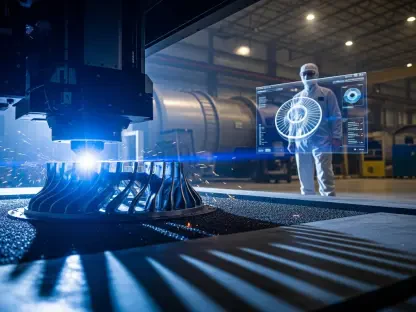What happens when a single deal could redefine how goods travel across the nation, impacting everything from grocery prices to manufacturing timelines? Union Pacific, a titan in the railroad sector, has unveiled an $85 billion merger proposal with Norfolk Southern, aiming to forge the first transcontinental rail network in American history. This audacious plan has set off a firestorm of debate, captivating industry leaders, policymakers, and everyday consumers who rely on the seamless movement of goods. The implications are vast, touching on economic growth, competition, and the very future of logistics in a rapidly evolving world.
The significance of this proposal cannot be overstated. Railroads remain a critical artery of the U.S. economy, transporting billions of dollars’ worth of goods annually. With Union Pacific reporting a robust third-quarter profit of $1.79 billion—a 7% jump from the prior year at $3.01 per share, surpassing Wall Street’s $2.97 per share forecast—this merger isn’t just about expansion; it’s about survival in a landscape where trucking and shipping innovations threaten rail’s relevance. As the U.S. Surface Transportation Board (STB) prepares for a lengthy review, the central question emerges: will this merger strengthen the supply chain or strangle competition?
A Railroad Giant’s Ambitious Leap
Union Pacific’s proposal to merge with Norfolk Southern isn’t merely a corporate maneuver; it’s a bold vision to unite the western and eastern rail networks into a seamless transcontinental corridor. Based in Omaha, Nebraska, Union Pacific already dominates much of the western U.S., while Norfolk Southern holds sway in the east. Combining forces, the companies argue, would slash transit times and costs for shippers, potentially revolutionizing how goods like grain, electronics, and industrial materials reach markets.
This isn’t a sudden whim but a response to mounting pressures. Despite achieving a 3% revenue growth through higher rates, Union Pacific’s carload volumes remain flat, signaling a need for transformative change. CEO Jim Vena has positioned the merger as essential, emphasizing in a recent employee letter that rail must adapt to compete with cutting-edge trucking technologies and global shipping giants. The stakes are high, as this deal could set a precedent for how industries consolidate to face modern challenges.
Economic Impacts of a Unified Rail Network
Railroads are more than steel and steam; they form the backbone of America’s supply chain, moving roughly 28% of the nation’s freight. A transcontinental network could streamline operations, cutting delays that ripple through to consumers in the form of higher prices or empty shelves. Proponents of the merger, including several major shippers, anticipate faster deliveries and lower costs, which could bolster industries reliant on just-in-time logistics, from automotive to retail.
Yet, the economic benefits come with caveats. Critics warn that consolidating two of the largest rail operators could grant Union Pacific unprecedented market power, potentially driving up rates for businesses with few alternative transport options. Chemical producers, for instance, fear a repeat of past mergers in the 1990s that led to service disruptions and price spikes. As the economy grapples with inflation and supply chain bottlenecks, the merger’s impact on pricing and access could either ease burdens or deepen them.
The broader context adds urgency to the debate. With logistics efficiency often determining a company’s bottom line, a misstep in rail consolidation could have cascading effects on national competitiveness. The STB’s review will need to balance these promises of efficiency against the risk of creating a monopoly-like entity in an already concentrated industry.
Dissecting the Deal: Support and Resistance
The $85 billion merger proposal carries a vision of progress, with Union Pacific touting reduced costs and enhanced service as key benefits. CEO Jim Vena has secured backing from the largest rail union, which sees job security and growth potential in a unified network. Several shippers have also voiced support, eager for a more reliable system to transport goods across vast distances without the hiccups of interchanging between rail operators.
Opposition, however, is fierce and multifaceted. Rival railroads such as BNSF, owned by Berkshire Hathaway, along with CPKC and Canadian National, argue that the merger threatens to choke competition. BNSF has mobilized its clients to submit concerns to the STB, highlighting fears of rate hikes and reduced service options. A spokesperson for BNSF stressed that cooperative agreements, not mergers, avoid the chaos of integration, citing historical mergers that left customers stranded amid operational failures.
Beyond industry rivals, other stakeholders add to the chorus of concern. Chemical manufacturers, heavily dependent on rail for bulk transport, caution that fewer players in the market could mean less bargaining power and higher expenses. Despite Union Pacific’s reported $41 million in merger-related costs this quarter, the financial burden pales compared to the potential long-term fallout critics foresee if competition dwindles.
Perspectives from the Frontlines
Jim Vena stands firm against the backlash, dismissing detractors as clinging to outdated thinking. In a pointed message to employees, he argued that rail must evolve to meet modern logistics demands, emphasizing that technology investments alone aren’t enough without a broader, integrated network. His stance is clear: without bold moves like this merger, rail risks losing ground to more agile transport alternatives.
Contrastingly, a BNSF representative countered that collaboration, not consolidation, offers a safer path forward. Pointing to the messy aftermath of past rail mergers, the spokesperson suggested that partnerships could achieve efficiency without sacrificing market diversity. This perspective resonates with many customers who recall service meltdowns following earlier industry consolidations, wary of history repeating itself.
Political dynamics further complicate the narrative. President Donald Trump has publicly nodded in favor of the deal, framing it as a boost to American infrastructure. Yet, with the STB’s review looming as a battleground for these clashing viewpoints, the merger’s fate hinges on whether regulators see it as innovation or a dangerous overreach. The diversity of opinions reflects the complexity of balancing progress with fairness in a critical sector.
Charting the Path Ahead: Options for Stakeholders
As the merger proposal moves toward regulatory scrutiny, actionable steps exist for those with a stake in the outcome. Shippers and customers can play a pivotal role by submitting detailed feedback to the STB, outlining how a combined Union Pacific-Norfolk Southern might impact their operations—whether through streamlined service or burdensome rate increases. Such input could shape the conditions under which the merger might be approved.
Policymakers, meanwhile, face the task of grounding their decisions in hard data. Examining the aftermath of prior rail mergers offers valuable lessons on maintaining service quality and market balance. A rigorous analysis of economic impacts, from job creation to consumer costs, will be essential to ensure the public interest isn’t sidelined in pursuit of corporate gains.
For industry players, exploring middle-ground solutions could ease tensions. Hybrid models that blend targeted cooperation with investments in digital tracking and automation might deliver efficiency without the risks of full consolidation. These approaches could serve as a compromise, ensuring that the rail sector evolves while preserving competitive dynamics vital to customer choice.
Looking back, the debate over Union Pacific’s ambitious merger with Norfolk Southern captured a defining moment for the rail industry. It highlighted a critical tension between the drive for innovation and the need to protect competition. As the STB deliberated, stakeholders from shippers to regulators had to weigh immediate benefits against long-term risks. Moving forward, the industry needed to prioritize transparent dialogue and data-driven solutions to ensure that any transformation in rail transport served the broader economy. The resolution of this merger saga promised to offer a blueprint for how legacy industries could adapt to modern challenges without losing sight of fairness and accessibility.









